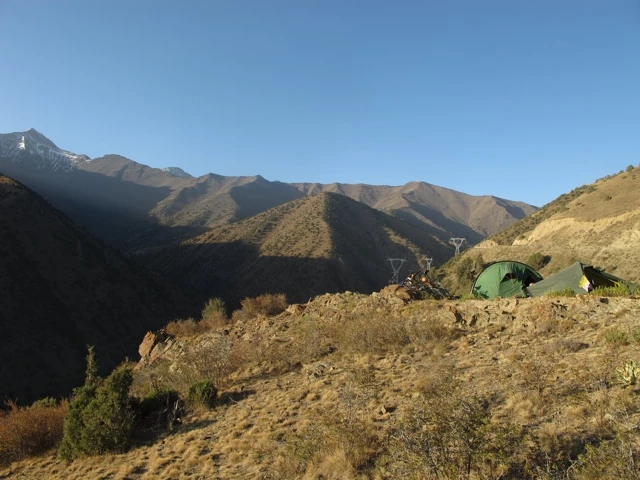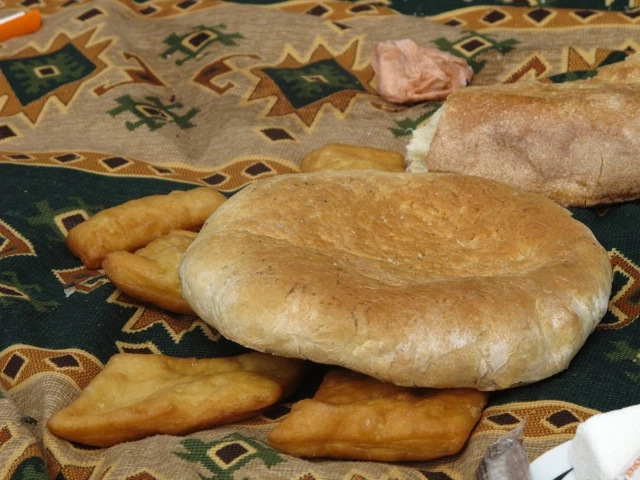Откуда ты?
Tuesday, September 13, 2011
- Silkroad
After I said goodbye to the Nomadbikefamily, the drive went to Buston to the border. Again, the road signaling was quite poor. When I wanted to ask the way at a house, the men invited me straight to dinner.

In the evening, I set up my tent 50 meters from the border with a farmer in his own country. They also wanted to invite me to their home. However, I was too tired and declined thankfully. Until the end, I was always treated very kindly by the people in Uzbekistan. Rakhmat Uzbekistan!
The border crossing from Uzbekistan to Tajikistan was almost without any problems. Although I had 18 missing days without registration, I was allowed to leave the police state on September 1, the twentieth anniversary of Uzbekistan's independence. The border official was delighted that he once again spoke English.
Shortly before Buston appeared the first street sign.

Initially, the road led through green fields and what surprised me very much: the road was in an absolute top condition. After that came a long, desert-like section. At a bus stop I cooked my lunch.

In the evening I quartered myself in Khujand in the hotel.

Khujand is the capital of North Tajikistan and the second largest in the country. At the time of Alexander the Great, it was the easternmost point of his empire. In 1986, during the Soviet era, the city was called Leninabad and celebrated its 2500th birthday. As a gateway to the Fergana Valley, mosques, palaces and citadels were built in huge proportions. In the early 13th century, however, the Mongols destroyed these colossal buildings. 75% of the agronomic area comes from here and two thirds from Tajikistan's gross domestic product.
The country is a Persian-speaking outpost in Central Asia.
In 1990, a brutal civil war claimed 50,000 lives. Today, the country is again considered safe and stable. Tajikistan is one of the thirtieth poorest countries in the world. More than 70% of the population lives on less than $ 2 a day. The 1300 kilometer border with Afghanistan is home to 80 percent of Central Asian drug smuggling. The country is thus the world's third largest country in heroin and opium trade. Up to 50% of economic activity is somehow linked to drug trafficking. Geographically, the country is quite interesting. 93% of the country's surface (143,100 square kilometers) is occupied by mountains and more than half of it is over 3,000 meters above sea level. That is why only 7 million people, about the same number as in Switzerland, live in the entire country.
Since 1992, Tajikistan has been a parliamentary republic with 230 parliamentary members. The parliament is headed by President Imomali Rakhmanov, who is already in his third period in office. In his re-elections, international election observers each criticized that the elections were neither "free nor fair". A referendum gave him the green light in 2003 to stay in office for another two terms of office until 2020.
Slowly the track got a lot more interesting the next day. The road is in perfect condition. By the evening I arrived in Istaravshan where I met Nora and Roman from Austria. We had already met in Samarqand and wanted to start together from Tashkent. My renewed diarrhea and visa problem had changed the plan a bit.
They started from Vienna in April and are now on their way to China and Southeast Asia via Eastern Europe, Georgia, Kazakhstan, Kyrgyzstan, Uzbekistan and Tajikistan. We drove on the next day to the Shahriston Pass.

This is located at 3378 meters above sea level. and for me was the highest point on my journey so far. The Chinese are building a tunnel through the mountain. The route over the pass is not paved but in dry condition still quite passable. We stayed in front of the pass and swallowed the last meters in the morning. At night it was really nice and cool for the first time. We even had to unpack our jackets. After three months in the desert, this was just super pleasant.

The landscape was also enormously varied. In Ayni we could deposit our bikes in the hotel and drove with a minibus the next day to Panjakent. There we were able to buy supplies and borrow two 60-liter rucksacks from the office of the Zeravshan Tourism Development Association ztda-tourism.tj. With another minibus the journey continued to Artush in the Alplager. Actually, the car was designed for only 8 people. Somehow, however, the driver managed to put 15 people in this box. It is fabulous!
Just above the Alplager we set up our first camp in the Fan Mountains.
These are one of the most popular hiking and climbing areas in Central Asia. We walked up to the Kulikalonsee the next morning. Past beautiful mountain streams and simple lodgings for shepherds and farmers in this region.

After a short lunch break at the lake we went again a few meters up to Dushakhasee.


The lake is located at the foot of Chimtargas and is 5489 meters above sea level. the highest peak in the region. Swimming in the lake was refreshing, but I did not last long. As a neoprene spoiled raft guide you are just too spoiled.
The hardest part came the next day as we crossed the Alaudin Pass (3860m). Fortunately, our circulation was already prepared a bit for this level. I felt my body try to produce red blood cells in a hurry. On the pass blew a rather unpleasant wind, which soon forced us to descent.

The paths were originally made with donkeys. Still today the locals use the donkeys as load carriers. As a result, the trails are sometimes quite steep and go especially on the descent quite nicely in the joints. At Lake Alaudin we set up our last camp. The wind became so strong that this time we gave up a campfire and went to bed pretty early.
The thighs were already burning almost the next day and for the first time in a long time I had sore muscles again. Walking and cycling are just two different things.
Fortunately, the descent to Murgab was reasonably pleasant.

Slowly we met more people again. At a settlement people invited us straight to Çay and food.


When they offered us a plate full of meat, we declined with thanks. They had a hard time understanding that there are people who do not eat meat. Nevertheless, we were allowed to stay. Great people! Especially the bread and the delicious pastries tasted delicious. After four days you miss these things right.
In Murgab we stayed in a homestay. They even had a shower! What a treat!
The next morning we took a taxi back to Ayni, where we saddled our bikes and drove on to Dushanbe. Again, the road is perfect to drive. But my darling gut management once again went crazy, so I prescribed antibiotics again. What actually worked.
After Dushanbe there are two possibilities: Either through the infamous Anzob Tunnel (under tourists it is also called "the Tunnel of Death") or the non-paved variant over the pass. We decided for the tunnel, but had to surrender because of the steep slope before and found a peasant family a night camp.
The Iranians have been quite ashamed of building the Anzob Tunnel. Water is pouring everywhere and huge potholes line the path. In addition, he is illuminated only very sparsely. Nora and Roman had previously seen movies on Youtube. Luckily, a pickup took us through the tunnel. Through the heavy blows broke my rearview mirror and Roman lost the fuel bottle for the stove. That was pretty annoying.
During the subsequent descent, my rear wheel began to beat more and more. Already in Iran I had caught a small eight in the wheel. Meanwhile, it was quite difficult to drive with it. I hoped to find a solution in Dushanbe.
In addition, there was a headwind all the time. Nevertheless, we reached the capital until the evening. Dushanbe is called "Monday" in Tajik. With the arrival of the railway in 1929, Dushanbe was appointed capital of the new Soviet Republic of Tajikistan and was henceforth called Stalinabad. With 600,000 inhabitants, it is the largest city in the country. In the guesthouse were a few other cyclists who tried to help me repair the bike. But after a short time the problem was found: Rim rip!
Luckily Philipp and Corina from Lucerne gave me their rear wheel sinvia.ch. They fly back home from Tashkent.

Engraziel fetg!
Now I am trying to extend my visa for Tajikistan here in the city, so I have enough time for the Pamir Highway. Supposedly, this should be pretty nerve-wracking. We want to see!